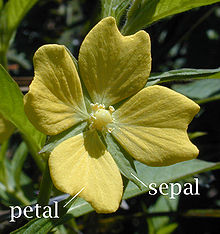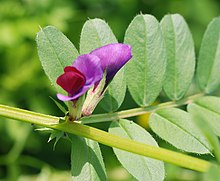Sepal
This article may be too technical for most readers to understand. (February 2021) |



A sepal (
Etymology
The term sepalum was coined by
Collectively, the sepals are called the calyx (plural: calyces),[7] the outermost whorl of parts that form a flower. The word calyx was adopted from the Latin calyx,[8] not to be confused with calix 'cup, goblet'.[9] The Latin calyx is derived from Greek κάλυξ kalyx 'bud, calyx, husk, wrapping' (cf. Sanskrit kalika 'bud'),[10] while calix is derived from Greek κύλιξ kylix 'cup, goblet'; both words have been used interchangeably in botanical Latin.[11]
Description
The term
The number of sepals in a flower is its merosity. Flower merosity is indicative of a plant's classification. The merosity of a eudicot flower is typically four or five. The merosity of a monocot or palaeodicot flower is three, or a multiple of three.
The development and form of the sepals vary considerably among flowering plants.[13] They may be free (polysepalous) or fused together (gamosepalous).[14] Often, the sepals are much reduced, appearing somewhat awn-like, or as scales, teeth, or ridges. Most often such structures protrude until the fruit is mature and falls off.
Examples of flowers with much-reduced perianths are found among the grasses.
In some flowers, the sepals are fused towards the base, forming a calyx tube (as in the family Lythraceae,[15] and Fabaceae). In other flowers (e.g., Rosaceae, Myrtaceae), a hypanthium includes the bases of sepals, petals, and the attachment points of the stamens.
Mechanical cues may be responsible for sepal growth and there is a strong evidence suggesting that microtubules are present and determine the tensile strength and direction of growth at a molecular level.[16]
Morphology
Morphologically, both sepals and petals are modified leaves. The calyx (the sepals) and the corolla (the petals) are the outer sterile whorls of the flower, which together form what is known as the perianth.[17] In some plants, such as Aristolochia, the calyx is the primary whorl, forming a flower up to 20 inches (51 cm) wide, with one sepal growing to a length of 13 feet (4.0 m) – Aristolochia grandiflora, the largest of all calyces.[18][19]
Function
Similarly to ordinary leaves, sepals are capable of performing photosynthesis. However, photosynthesis in sepals occurs at a slower rate than in ordinary leaves due to sepals having a lower stomatal density which limits the spaces for gas exchange.[20]
After flowering, most plants have no more use for the calyx which withers or becomes vestigial, although in a few plants such as Lodoicea and eggplant (Solanum melongena) the calyx grows along with the fruit, possibly to protect the attachment point. Some plants retain a thorny calyx, either dried or live, as protection for the fruit or seeds. Examples include species of Acaena, some of the Solanaceae (for example the Tomatillo, Physalis philadelphica), and the water caltrop, Trapa natans. In some species, the calyx not only persists after flowering but instead of withering, begins to grow until it forms a bladder-like enclosure around the fruit. This is an effective protection against some kinds of birds and insects, for example in Hibiscus trionum and the Cape gooseberry. In other species, the calyx grows into an accessory fruit.
See also
References
- ^ From French sépale, from Neo-Latin sepalum, a blend of sep- from Greek skepē 'covering' and -alum from Neo-Latin petalum 'petal', influenced by French pétale 'petal'.
- ^ "Oxford Languages | The Home of Language Data". languages.oup.com.
- CollinsDictionary.com. HarperCollins.
- ISBN 978-1-84246-422-9., p. 106
- ISBN 0-88192-321-4
- ^ Necker, N.J. de (1790). Corollarium ad Philosophiam botanicam Linnaei 18, 31
- ISBN 978-0199206872.
- ^ Jackson, Benjamin, Daydon; A Glossary of Botanic Terms with their Derivation and Accent; Published by Gerald Duckworth & Co. London, 4th ed 1928
- ^ John Entick, William Crakelt, Tyronis thesaurus, or, Entick's new Latin English dictionary. Publisher: E.J. Coale, 1822
- ^ Tucker, T. G. (1931). A Concise Etymological Dictionary of Latin. Halle (Saale): Max Niemeyer Verlag.
- ^ Stearn, William T. (2000). Botanical Latin, 4th ed.: 38
- ^ Beentje 2010, p. 119
- ISBN 0-8020-1864-5.
- ^ Beentje 2010, pp. 51 & 91.
- ^ Carr, Gerald. "Lythraceae". University of Hawaii. Archived from the original on 5 December 2008. Retrieved 20 December 2008.
- PMID 27151660.
- ISBN 0-521-29359-6.
- ^ Rohwer, Jens G. (2002). Tropical Plants of the World. New York: Sterling. p. 208.
- JSTOR 2394940.
- S2CID 24426595.
